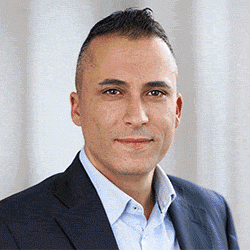"New solutions are needed to reasonably reduce light emissions"
As part of this year's Light Academy, Sascha Nussbaumer opened the block "As much light as necessary, as little as possible", where it was about the possibilities and trends in the field of light emissions and sustainability. And offered us an exciting insight or rather outlook into the stars.
Under discussion
 Sascha has been volunteering with the Astrogruppe Jurasternwarte Grenchen for over 16 years. In this interview, he talks about the fascination of the night sky, the consequences of light pollution on it, and how his enthusiasm for technology, nature, and environmental protection is also reflected in his everyday work.
Sascha has been volunteering with the Astrogruppe Jurasternwarte Grenchen for over 16 years. In this interview, he talks about the fascination of the night sky, the consequences of light pollution on it, and how his enthusiasm for technology, nature, and environmental protection is also reflected in his everyday work.

Fascination Night Sky - Sascha, what excites you about the stars?
On the one hand it is the unbelievable natural spectacle, which is offered to us every night. It is supposed that over 70 trillion stars exist in our universe. To see them shine is beautiful even without telescopes. In the universe, life and death are close to each other. Stars form and dissolve in huge explosions again in air. We humans do not know partly at all which we have for an unbelievable luck on such an inconspicuous nevertheless beautiful planet to be allowed to live.
.On the other hand, it is the technology that fascinates me. Today, even amateur astronomers have very good telescopes, trackers and astro cameras at their disposal that produce beautiful astronomy images. In the past this meant long nights, a lot of manual work and many setbacks in developing the (analog) photos. Today, everything is digitized. From automatic tracking to the digital camera to capture the night sky.


What do we need to do to make it easier to see? Is the need for light a problem for you guys at the observatory?
In recent decades, light pollution has become more widespread. The Milky Way, our home galaxy, is almost impossible to see in urban areas. On our honeymoon I had such a real aha experience. We were on a sailing cruiser in the Mediterranean. When we were on the open sea, I saw the sky really clear and dark for the first time. As soon as you turned your gaze to the coast, you saw how the horizon became more milky again. It is the artificial light that makes it more and more difficult to see the sky. New solutions are needed to reasonably reduce the emissions of light. A good example is the community of Oberdorf in the canton of Solothurn. Here, public lighting is switched off through the week from 1 to 5 o'clock. There are certainly smarter solutions, where light can be switched on as needed. The rule is as much light as necessary and as little as possible.
From the stars to the Lab: What moved you to get involved in the founding of the Smart Ctiy Lab Grenchen? What goals are you pursuing with the Lab?
The foundation of the Smart City Lab Grenchen arose from a collaboration between our company Sensioty and the municipal economic development. Our company deals with smart solutions for the Internet of Things (IoT), which we want to use for smart city applications. The economic development agency, in turn, would like to promote the mix of industries by allowing the industrially dominated city to also develop in the direction of digitalization. We have come to the conclusion that cooperation will generate benefits for both sides.
The idea behind it is to connect the city, businesses and residents of Grenchen so that new ideas for digital, efficient and sustainable urban development can be promoted. The city quickly realized that a pure top-down development will not work. It needs initiatives from below and the support of the city and politics so that new things can emerge. We founded the association on 08 April. Next, we are planning various events on smart city topics such as mobility, smart living and citizen participation.
Look at the stars - what projects are coming up in Grenchen?
The establishment of the Smart City Lab has triggered quite a few new ideas. We are together with partners on trials in the field of smart metering, smart lighting, as well as smart property protection of remote buildings.
Jura Astronomical Observatory, Grenchen
Image and video material was kindly provided by the Astrogruppe Jurasternwarte Grenchen.










